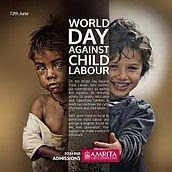Child Labour A Dark Reality Demanding Awareness And Action
Despite progress in education and child rights across the world, child labour remains a harsh reality in many parts of the globe. Millions of children are still forced to work under dangerous, unhealthy, and exploitative conditions—often at the cost of their education, health, and freedom.
🧒 What Is Child Labour?
Child labour refers to the employment of children in work that:
Is mentally, physically, socially, or morally dangerous and harmful;
Interferes with their schooling;
Deprives them of their childhood and potential.
It is different from simple chores or helping with family businesses in safe ways. Child labour is exploitative when it robs children of their education, safety, and basic rights.
🌍 Where and Why Does It Happen?
Child labour is most common in developing countries, especially in sectors like:
Agriculture
Mining
Textiles and garment factories
Domestic work
Street vending
The main causes include:
Poverty: Families unable to meet basic needs often depend on children to earn.
Lack of education: When schooling is unaffordable or inaccessible, work becomes the only option.
Cultural norms: In some regions, child labour is seen as part of growing up.
Weak laws or poor enforcement: Even where child labour is illegal, enforcement maybelex
📊 Shocking Statistics
According to the International Labour Organization (ILO):
Over 160 million children (almost 1 in 10 worldwide) are involved in child labour.
Half of them work in hazardous conditions.
Sub-Saharan Africa has the highest number of child labourers, but it's a global issue.
💔 The Impact on Children
The effects of child labour are severe and long-lasting:
Physical harm from dangerous work
Emotional and psychological trauma
Interrupted education, leading to lifelong poverty
🚫 What Can Be Done?
Ending child labour requires a multi-level approach:
Government action: Stronger enforcement of labour laws and investment in free, quality education.
Community education: Raising awareness about the dangers of child labour and the value of education.
Corporate responsibility: Companies must ensure their supply chains are free from child labour.
Consumer choices: Buying ethically-sourced products can make a difference.
Support NGOs: Organizations like UNICEF, Save the Children, and the ILO work directly to protect children.
🕊️ A Shared Responsibility
Child labour is not just a problem in distant places—it’s a global issue that calls for global empathy and action. Every child deserves a safe, healthy, and happy childhood, not one burdened by work.
Ending child labour is not easy,but if we work together.

Comments
Post a Comment